The Samsung Galaxy S6 and S6 edge Review
by Joshua Ho on April 17, 2015 9:00 AM EST- Posted in
- Smartphones
- Samsung
- Mobile
- Galaxy S6
- Galaxy S6 Edge
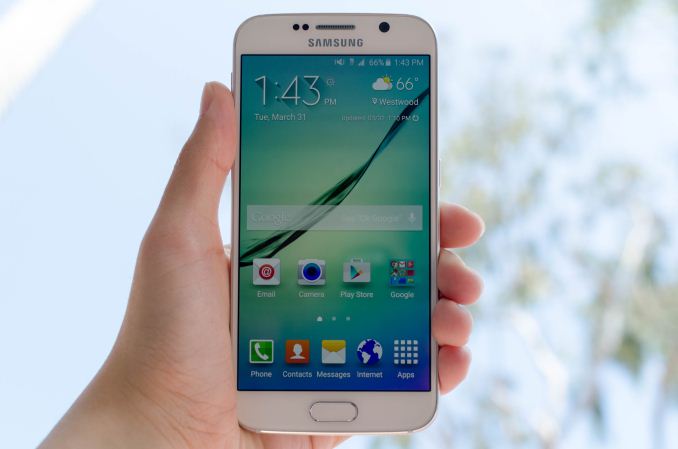
As recently as the Galaxy S5, Samsung had a fundamentally different strategy from companies like HTC and Apple. While design wasn’t ignored completely, Samsung Mobile had a different set of priorities. In general, it felt like Samsung wanted the phone to have every feature possible to please every possible potential customer. Features like a removable battery and microSD card slot seemed to be a crucial point of differentiation. TouchWiz focused on delivering a full suite of applications even if they were pretty much redundant when compared to Google’s applications. Samsung also seemed to cost-optimize their external shells, favoring polymer builds over glass or aluminum. Since the Galaxy S, this strategy paid off handsomely. With the help of strong marketing, Samsung proceeded to dominate the Android market from the days of the Galaxy S2, to the point that almost no other Android OEM was relevant in terms of market share.
However, Samsung’s tried and true strategy failed with the Galaxy S5. Fundamentally, Samsung had always been competing with Apple and their iPhone line-up at the high end, but Samsung consistently held a price advantage. The real problem was the rise of low-cost flagship phones, which squeezed Samsung significantly. Other OEMs were able to justify their high-end pricing by delivering a polished software experience and premium hardware design. In comparison to these relatively cheap phones which delivered largely the same experience and hardware, Samsung’s sales crumbled and the Galaxy S5 didn’t meet sales expectations.
This brings us to the Galaxy S6, which is supposed to be Samsung’s attempt at refocusing their product design and lineup. Design has become a major priority, and the Galaxy S6 is a radical departure from previous design in terms of almost every design choice. The Galaxy S6 represents the best that Samsung can make to some extent, as a great deal of the phone is composed of Samsung-made parts to achieve maximum vertical integration as seen in the specs below.
| Samsung Galaxy S5 | Samsung Galaxy S6 | Samsung Galaxy S6 Edge | |
| SoC | MSM8974ACv3 2.45 GHz Snapdragon 801 | Exynos 7420 2.1/1.5GHz A57/A53 | Exynos 7420 2.1/1.5GHz A57/A53 |
| RAM | 2GB LPDDR3 | 3GB LPDDR4-1552 | 3GB LPDDR4-1552 |
| NAND | 16/32GB NAND + microSD | 32/64/128GB NAND | 32/64/128GB NAND |
| Display | 5.1” 1080p SAMOLED HD |
5.1” 1440p SAMOLED |
5.1” 1440p SAMOLED, Dual Edge |
| Network | 2G / 3G / 4G LTE (Qualcomm MDM9x25 UE Category 4 LTE) | 2G / 3G / 4G LTE (Category 6 LTE) | 2G / 3G / 4G LTE (Category 6 LTE) |
| Dimensions | 142 x 72.5 x 8.1 mm, 145 grams | 143.4 x 70.5 x 6.8mm max, 138 grams | 142.1 x 70.1 x 7.0mm max, 132 grams |
| Camera | 16MP (5132 x 2988) Rear Facing with 1.12 µm pixels, 1/2.6" CMOS size, 31 mm (35mm effective), f/2.2 | 16MP (5132 x 2988) Rear Facing w/ OIS, f/1.9, object tracking AF | 16MP (5132 x 2988) Rear Facing w/ OIS, f/1.9, object tracking AF |
| 2MP Front Facing | 5MP Front Facing, f/1.9 | 5MP Front Facing, f/1.9 | |
| Battery | 2800 mAh (10.78 Whr) | 2550 mAh (9.81 Whr) | 2600 mAh (10.01 Whr) |
| OS | Android 4.4 w/TouchWiz |
Android 5 (64-bit) w/TouchWiz | Android 5 (64-bit) w/TouchWiz |
| Connectivity | 802.11a/b/g/n/ac 2x2 + BT 4.0 (BCM4354), USB3.0, GPS/GNSS, MHL, DLNA, NFC |
2x2 802.11a/b/g/n/ac + BT 4.1 (BCM4358), USB2.0, GPS/GNSS, NFC |
2x2 802.11a/b/g/n/ac + BT 4.1 (BCM4358), USB2.0, GPS/GNSS, NFC |
| Wireless Charging | N/A | WPC 1.1 (4.6W) & PMA 1.0 (4.2W) |
WPC 1.1 (4.6W) & PMA 1.0 (4.2W) |
| Fingerprint Sensor | Swipe | Touch | Touch |
| SIM Size | MicroSIM | NanoSIM |
NanoSIM |
Design
There’s a lot of ground to cover in the Galaxy S6 and S6 edge, but probably the most immediate change is to the design. The Galaxy S6 is a unibody design, with no apparent screws. This does mean that there’s no removable battery or microSD slot, which shouldn’t be a problem for most people although this may be enough for some to write off this phone completely.
The back cover is now glass instead of plastic, and is attached to the phone with glue instead of plastic latches. Regardless of color or model, Samsung has placed an extremely fine pattern beneath the glass that manages to be subtle but also surprisingly brilliant under direct light. It’s tasteful in a way that the Galaxy S5 and Note 4 weren’t. The back of the phone also has a single LED flash, a heart rate monitor, and the camera which bulges out significantly. I personally don’t have a problem with camera humps, but the Galaxy S6’s camera hump is probably the biggest I’ve seen in recent memory.
The glass back cover meets the metal frame of the phone, which provides most of the structural rigidity and strength. On the normal Galaxy S6, this frame has a very slight curve and is almost cylindrical along the top and bottom of the phone, but flattens out along the sides for better grip. The bottom of this frame has the speaker, microUSB port, and 3.5mm headphone jack, which does make for some resemblance with Apple products launched within the last year. At any rate, the placement of the speaker, USB port, and 3.5mm jack are all appropriate for a phone.
The left side of the frame contains the volume buttons, which are clicky and solid, although pressing the buttons off-center does produce a noticeable flex. The right side of the frame has the power button and the nanoSIM slot on the normal version.
On the edge variant, the sides of the frame are dramatically thinner and appear to be angled out when compared to the Galaxy S6. In the hand, this makes it feel much thinner than the S6, but it really feels almost too thin to hold comfortably. Combined with the flat back, it’s really a bit of a struggle to pick up the edge off of a table, which compromises usability when compared to the normal S6.
The top of the frame contains the IR LED for TV capabilities and a hole for a microphone. On the edge variant, the nanoSIM slot is relocated to the top of the phone.
The front of the phone is probably the only aspect of the design that feels relatively similar to the Galaxy S5. However, the texture of the bezel beneath the glass is similar to the subtle finish of the back cover, which makes for a unique visual effect that manages to be tasteful and quite unique. Other than this, we see the same layout as most Galaxy phones, with two capacitive buttons (multitasking on the left, back button on the right) and a physical home button. In the case of the Galaxy S6, this home button has been turned into a fingerprint scanner that is touch-based rather than a swipe sensor. Along the top of the front face, we also see the ambient light sensor, a proximity sensor, the earpiece, and the 5MP front-facing camera. Directly below these items is the display driver beneath the bezel, which is similar to the “logo bar” of the One M7, M8, and every other phone on the market today. On the S6 edge, the sides of the display are curved to reduce the width of the phone, which does make it easier to hold in the hand, but there’s really no bezel reduction here as the side bezels seem to be larger than what we see on the S6.
Overall, the design of the Galaxy S6 and S6 edge is really unlike anything else they’ve produced in recent memory. The phone itself is well-sized and feels much more ergonomic than the Galaxy S5 due to the thinner build and mildly reduced bezel size. It really feels like Samsung cared about the design of the phone this generation, and the attention to detail here immediately puts Samsung near the top in this area. The front of the phone still feels a bit derivative, but I suspect that there isn’t much Samsung can do to change this when faced with design constraints like a physical home button. The S6 edge does look better in some ways, but ergonomically the sharper and thinner edge is a compromise compared to the normal S6. Either phone is still easily one of the best-designed phones I’ve seen this year.


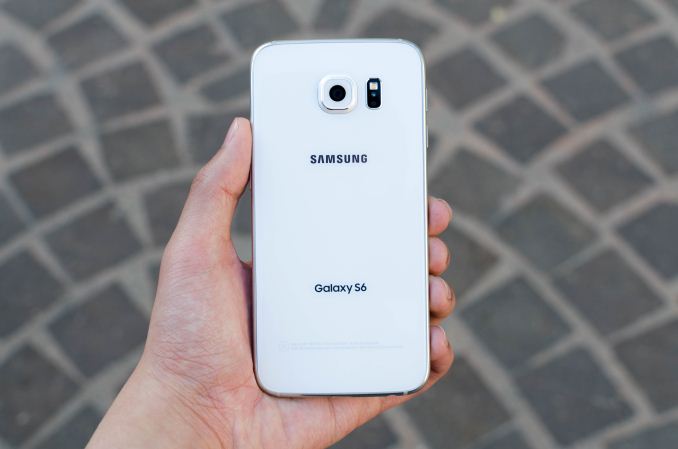
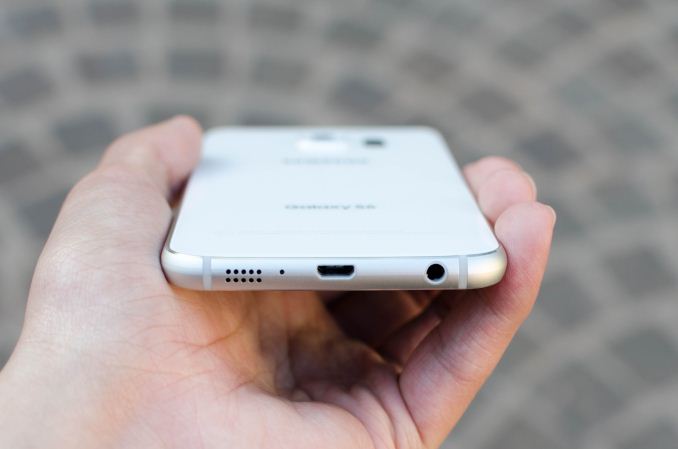
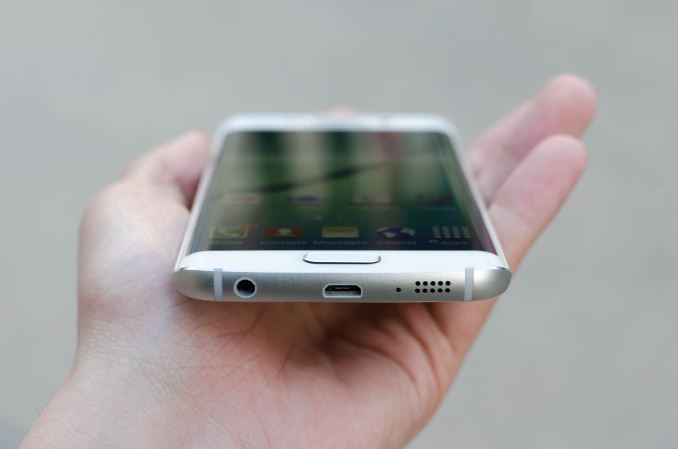



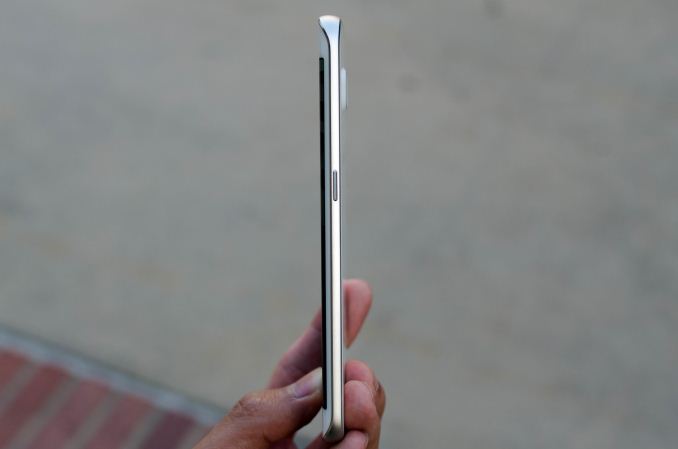

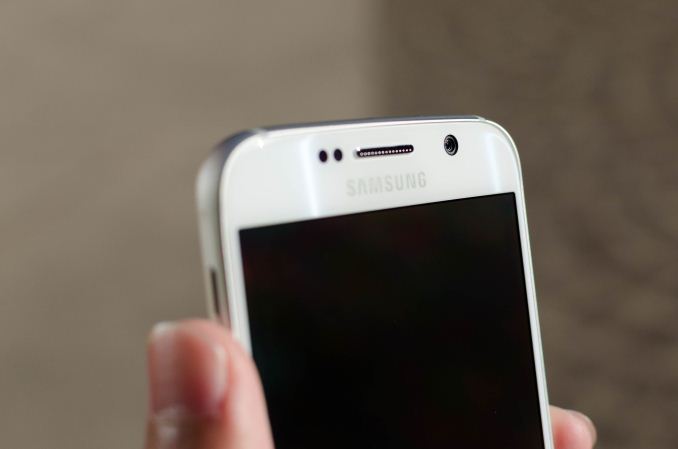
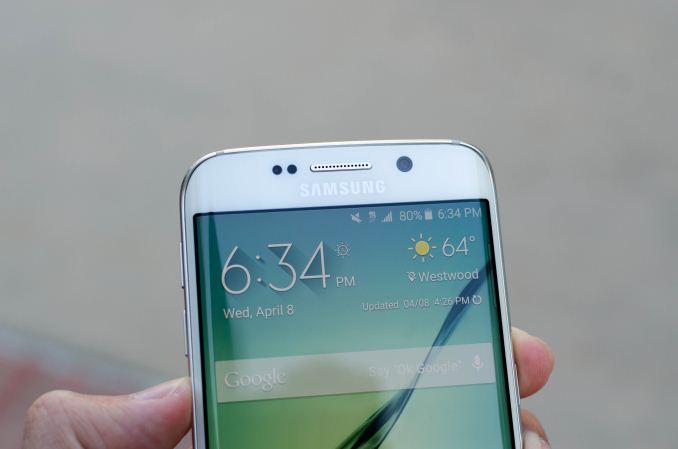








306 Comments
View All Comments
bogda - Saturday, April 18, 2015 - link
External SD on Android is mostly for media files so for me capacity is much more important than performance. Songs and videos will play the same regardless of SD speed.I am not going to watch video at 8x speed.Notmyusualid - Saturday, April 18, 2015 - link
To be honest, I'm happy you are happy with your purchase.To me, it looks gorgeous, but it seems a tiny step down from my GS5. No micro sd slot, no removable battery, no waterproofing (a big one this), and I notice the GFX Bench had worse battery life too.
That record charge time might persuade me, if I were to lose my GS5 drunk etc. But then a second-hand GS5 is a bargin now.
ethebubbeth - Friday, April 17, 2015 - link
My LG G3 has both removable battery and a microSD slot. Here's hoping they continue to carry the torch since it appears that Samsung has dropped it.Ammaross - Friday, April 17, 2015 - link
We'll find out at the end of the month when they announce the LG G4. I'm waiting to see/hear specs on it (officially) before pulling the trigger with an S6. The loss of the SD slot is a bit painful when you have to pony up an extra $100 for a measly extra 32GB....akdj - Friday, April 24, 2015 - link
Or two hundred for incredibly fast internal NAND storage, a bump of 96GB.I've owned each iteration of the Note (business line) except Note 2. Still have the Xoom. iPhones, same --- our employees carry them and I use the 6+ as my personal phone. I didn't upgrade Note 1 --> 2, as I couldn't get out of Note 1 quickly enough (contract). Slow as molasses. 2 changed that, and when it was time to get rid of it, the Note 3 was entirely new 'experience-wise' in comparison. Ten times quicker! I've had the Note 4 since release and I've found the further we move up in Android versions, the less 'control' I've had over where and what storage I'm able to keep on the microSD card
Media, for sure....but for two bills more, over two years is $8/month for 128 GB. I've got the 6+/128 and I've never felt pinched. Even with 3 & 4GB HD movie files I've not compressed. Battery life is incredible on both and other than extended oversea flights I've never had a problem. I also have a TB or 4 at home sharable to the remote phones and tabs from the house but I've never needed to re download extra music or motion while on holiday travel. Best to get out and see the scenery than watch our phones.
128 is a large chunk of internal data to hold. And it's 'not' expensive. If you're a DSLR shooter and use CF cards, motion, or proprietary capture (P2, SxS, RED's SSDs, etc.) --- you know how expensive a 'fast' card is. Even the quickest can't hold a candle to the latest Sammy and Apple MLC/TLC storage. Stairway to Heaven is going to sound the same when you get home but the ability to capture the shots you want, motion and speeds or different resolutions keep the internal NAND's speeds, reliability and prices continue to rise (first two), and drop (price) for these sealed, internal storage modules.
As for batteries ...I've also owned each iPhone and other than Mophie cases on the smaller phones, I've found no such need on the 6+, from the scores shown here...that'll be the case with the S6 as well.
Peichen - Saturday, April 18, 2015 - link
Seems like LG G4 will have removable back, battery and a microSD slot according to leaks.Lonyo - Friday, April 17, 2015 - link
They lost me. My new phone (replacing an S3) arrived yesterday. It has a MicroSD slot and a removable battery.I'm using a MicroSD card in it. It's the one I had in my S3.
Samsung want me to pay $200 premium to upgrade from 32GB to 128GB when I already own 128GB of phone-compatible storage. They can shove it.
Notmyusualid - Saturday, April 18, 2015 - link
+1juxt417 - Wednesday, April 22, 2015 - link
Hope you have everything backed up for if/when that bad boy fails. I gave up on SD cards after mine burnt out.ahw - Friday, April 17, 2015 - link
SD Card slot is the bigger issue, IMO. Samsung has already lost a customer: me. I have an S4 and am eligible for an upgrade. It won't be the S6.